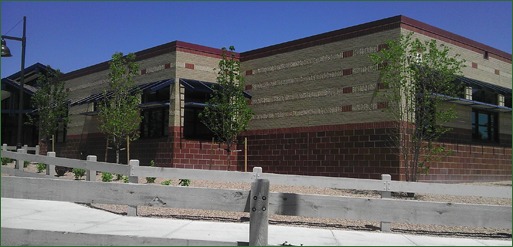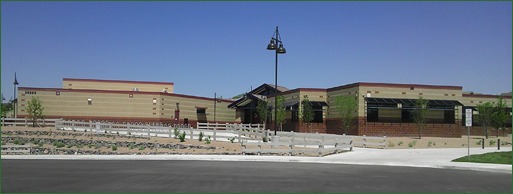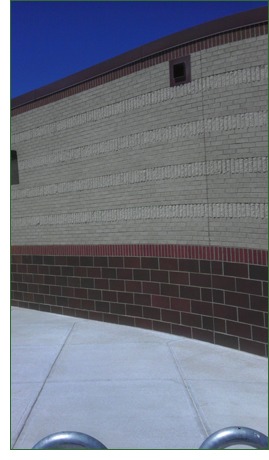Cleaning
Pressure and Masonry Cleaning
Relaying some lessons learned from professional cleaners

While there is always pressure to finish masonry cleaning quickly and thoroughly, this article focuses on the use of pressure in the application of water and chemicals in the cleaning process.
As the time approached for the masonry cleaning of Black Forest Hills Elementary School, a part of Cherry Creek Schools in Aurora, Colo., the architect took a strong position that the walls needed to be cleaned with only water and a brush. After some conversation, he relented and allowed the use of chemicals and pressure washing on the beige and split-face bricks, brown CMUs and red bricks. However, the architect’s stipulation was that the chemical and water needed to be applied under very low pressure.
There are some common misconceptions about cleaning by applying chemicals and water under pressure. Those perceptions were changed as we worked through this situation.
Jim Serowski, principal of Commerce City, Colo.-based JVS Masonry, and his masonry cleaner, Robert Copeland, have been valued customers of ours for many years. When this challenge confronted them, we welcomed the opportunity to help set up one of their two Kem-O-Kleen Masonry Cleaning Systems to suit the requirements.
First, if you are not familiar, it is important to understand how pressure in a pressure washer works. Typically, the machine’s pressure is measured on a pressure gauge just after the pump. A person looks at the gauge, sees 3,000 psi, and may think that is the pressure hitting the wall. For those of you who think that, be prepared for a surprise.
The nozzle at the end of a pressure washer’s wand is the narrowest part of the water path. This restriction causes the water to back up and build pressure behind it, until the pressure is great enough to push the water through the small orifice in the nozzle. Along the way to the nozzle, there are friction losses in the coil and hose, which reduce the pressure. More specifically, for a 4-gpm water flow, 200 feet of ??-inch coil reduces pressure by about 50 psi, and 200 feet of 3/8-inch hose reduce the pressure by an additional 180 psi. The most dramatic change, however, occurs after the nozzle.

For those of you who like math, the formula for impact, the pressure exerted against the wall at 12 inches from the wand, with a 0-degree nozzle, is:?? I = K x Q x ???P, where K = 0.0526, Q = gpm, and P = psi. For those of you who don’t like math, the answer is 11 psi. To be clear, a 3,000 psi/4 gpm pressure washer with a 0-degree nozzle, generates 11 psi, 12 inches away from the nozzle. A fan spray pattern diffuses the impact that a 0-degree nozzle would have. Because we were using a 15-degree flat fan nozzle, the impact is reduced to 30 percent of the 0-degree impact, or 3.3 psi. So, 3,000 psi at the pump actually is 3.3 psi on the wall at 12 inches away from the nozzle.
 Twelve inches is a little closer than most people position the nozzle, relative to the wall. Of course, moving the wand further away from the wall would continue the precipitous drop in impact pressure.
Twelve inches is a little closer than most people position the nozzle, relative to the wall. Of course, moving the wand further away from the wall would continue the precipitous drop in impact pressure.
The architect still had some discomfort. So, we adjusted the pressure downward on the machine, all the way down to 300 psi on the gauge near the pump (simple unloader adjustment). We replaced the wand nozzle with a wider fan (25 degree). That brought the impact pressure down to 0.153 psi, less than one-sixth of a pound of pressure per square inch, at 12 inches from the nozzle.
The chemical used was Vanatrol. The architect watched cleaning in action and was impressed. He looked at the results once the wall had a chance to dry, and was pleased. Of course, the cleaning was more consistent and done in a fraction of the time it would have taken with just water or manual methods.
Black Forest Hills Elementary School has been completed. The administrators already are occupying the building and told me how proud they are of their school and much they are looking forward to students who will be starting this coming August. I think you’ll agree that it is a beautiful school.
| Product Watch |
| Steam Jenny introduces four new models of belt-drive cold pressure washers. Designed for heavy use, belt-drive pressure washers provide a longer pump life than direct-drive units. The extended service life is due to the pulley system, which turns the pump significantly slower than if the pump were coupled with the engine crankshaft. Additionally, the belt absorbs engine vibration and allows the pump to be located farther away from the engine heat. All models are designed for maximum durability and portability to meet the demands of commercial-duty applications.
The pressure washers are powered by 9- or 13-horsepower Honda GX Series engines, and all models feature a triplex ceramic plunger pump that provides years of service while requiring little maintenance. The units offer an ideal balance between power and volume. They are available with pressure ratings between 3,000 and 4,000 psi, and flow rates vary between 3 and 4 gpm. Furthermore, a customizable option allows customers to choose a unit with pressure and flow ratings based on their specific needs. Many standard features are incorporated into the line to ensure long service life. These include thermal pump protection, an unloader valve and a high-pressure relief valve to prevent damage to the pump. To protect the engine, the unit will automatically shut down if low oil levels are detected. Furthermore, the chassis is made with powder-coated, seven-gauge steel for enhanced durability. Other standard items include a professional-grade insulated trigger gun with safety lock; quick-connect nozzles with nozzle control; high-capacity, in-line water strainer; gun/wand holder; hose reel mounting adapter; and dual rubber isolators. The chassis is backed by a seven-year, limited warranty, and other components are covered by a one-year limited warranty. For maximum maneuverability, the pressure washers feature ball bearing wheels on a solid axle. The flat-free pneumatic tires move over any terrain. Visit www.steamjenny.com for more information. |
randy.weil@uniqueindustries.com.